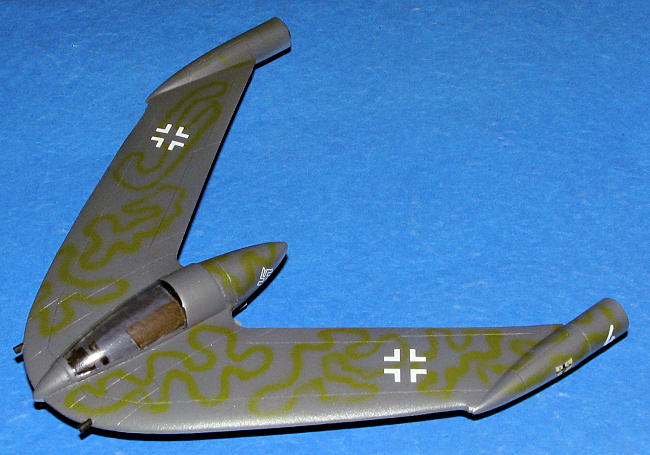
| KIT #: | ? |
| PRICE: | $48.00 from www.fantastic-plastic.com |
| DECALS: | Two options |
| REVIEWER: | Scott Van Aken |
| NOTES: | Resin with vacuformed canopy |

| HISTORY |
Germany's Horten Brothers are credited with being some of aviation's earliest champions of the "flying wing" concept. In addition to designing both propeller- and jet-powered flying wings, the Brothers Horten developed plans for an advanced fighter powered by twin rocket motors. Discovered by the Allies in the waning days of WWII, these plans never got beyond the initial design stages, yet even in their crude, undeveloped state suggested a plane that -- if built -- would have been one of the most elegant and beautiful ever to take to the skies.
The above was blatantly cribbed from the Fantastic Plastic instruction sheet as I could find nothing about this design in the few Luft 46 references I have.
| ALTERNATE HISTORY |
It is a cold winter morning in December of 1946. Dieter Johanssen does not want to get out of his warm bunk, but the duty sergeant will not let his sleep in. "Come on Lt Johanssen. If you don't get up, you'll miss breakfast. The cook has promised two eggs with bacon, and if you don't eat it, I will!".
 With this very real threat looming over him, Dieter
slowly gets up and dresses for the day. He pulls on his heavy winter gear and
shuffles through the mud/snow mix to the mess hall where he is delighted to see
that there really are eggs and bacon for breakfast. What a treat. Must be the
closeness of the holidays to provide such luxury items. He was getting very
tired of potato everything for meals! How he ever got based here at Bødø, Norway
is beyond him, but he suspects it has a lot to do with the aircraft he is
flying. It is so typical of the Luftwaffe to do the first operational basing of
a new plane out in the edges of the war. Probably so that if something goes
wrong, it won't be generally known.
With this very real threat looming over him, Dieter
slowly gets up and dresses for the day. He pulls on his heavy winter gear and
shuffles through the mud/snow mix to the mess hall where he is delighted to see
that there really are eggs and bacon for breakfast. What a treat. Must be the
closeness of the holidays to provide such luxury items. He was getting very
tired of potato everything for meals! How he ever got based here at Bødø, Norway
is beyond him, but he suspects it has a lot to do with the aircraft he is
flying. It is so typical of the Luftwaffe to do the first operational basing of
a new plane out in the edges of the war. Probably so that if something goes
wrong, it won't be generally known.
Frankly, Dieter thinks that the aircraft is a bit much, though he does think that it has possibilities. Image a rocket powered aircraft where one spends his time on his stomach. It has given him a huge pain in the neck, but he's been told there is a remedy for that. What he'd like is a proper seat as he always feels as if he is going to slide out of his harness. He had his 'black man' (or crew chief) rig up a chin brace for him and that seems to have helped, but he keeps sliding off it during maneuvers.
Fortunately, there isn't a whole lot of action up here. Basically he is here to prevent the Allies from interfering with shipping going into Murmansk. Though Germany is still unable to take Moscow, thanks to help from the Finns, at least Leningrad and Murmansk are in Axis hands. Now if the darn British could be forced off their island. Two invasion attempts have proved fruitless with a large loss in life on both sides.
It is fortunate that the Americans are no longer in the war. With the Japanese basically pushing them out of the Pacific in 1942 and their losses in North Africa in 1943/44, the new president sued for a cease-fire and part of that was an agreement not to supply belligerents with war supplies and equipment. Food and humanitarian goods can be transported, but at the risk of losing a ship to marauding submarines. This has basically left the Commonwealth to supply the British and the Russians are doing fairly well to hold off the German Army. Africa is basically Axis from the Sahara north up through the Near East and into the oil fields of Iraq and the Russian Caucasus. Turkey is still neutral and along with Switzerland, Eire, and Sweden they provide the contacts needed even in war. However, the Brits hold Iceland, the northern islands of the UK and Greenland, from which they send long range bombers to attack German shipments headed for Murmansk as the overland routes are still dangerous and take far too long.
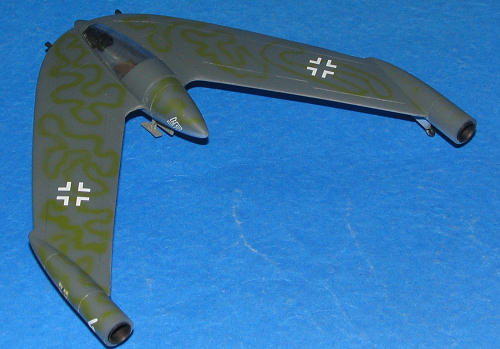 The new Horton Ho-336 that Dieter is flying is a
modification of the original prototypes in that the size of the aircraft is
larger and the powered flight time has been increased to nearly a half hour, thanks to improvements in fuel and more efficient rocket engines. The
ability to throttle these engines means that they can be shut off to allow the
plane to glide for a period before starting them back up as needed. Thanks to
their good gliding properties, the aircraft can stay airborne for a considerable
time. Enough to make them useful as combat aircraft.
The new Horton Ho-336 that Dieter is flying is a
modification of the original prototypes in that the size of the aircraft is
larger and the powered flight time has been increased to nearly a half hour, thanks to improvements in fuel and more efficient rocket engines. The
ability to throttle these engines means that they can be shut off to allow the
plane to glide for a period before starting them back up as needed. Thanks to
their good gliding properties, the aircraft can stay airborne for a considerable
time. Enough to make them useful as combat aircraft.
After a good breakfast, Dieter heads of the ready room to await any enemy incursion. Their field has been specially prepared for them and has either a coating of grass, or in this weather, snow as the plane operates from skids. After take off, the ground crew have to pile in new snow as the rockets will nearly instantly melt what is behind them. This is also the reason for the individual blast fences and having each plane aimed straight down the field.
As he is dozing off, a report of an incoming raid comes to the squadron ops officer. More long range bombers from the Brits heading for another Murmansk bound group of ships from Argentina. Probably with foodstuffs. A steak would be great! Still an hour or so away, which give the pilots time to be casual about it. Rockets mean fast so they'll wait until the bombers move closer. That will give more time to attack them. Dieter and his friends head for the pens where their planes are held. Unlike other aircraft, no ground support gear is needed other than a ladder to allow Dieter to get in the plane. The on-board battery will open a valve and start fuel into the engines.
Dieter and his comrades get strapped in and await the flare gun to announce take-off. The intercept bearing is provided by the band of radar stations and will be updated as needed via secure radio. There is a white flare! Take-off in less than two minutes. Dieter tightens his belts and braces his feet on the rudder bar. Take off controls are automatic until the aircraft gets to a preset altitude, this one being 15,000 meters, at which time control is returned to the pilot. Too many pilots were blacking out early and losing control of the plane. This automated system allows a pilot a chance to come to in time.
Green flare and Dieter pushes the ignition button. The aircraft leaps down the runway and then zoom climbs under near full power. As the first off, Dieter doesn't have to worry about running into the other guys. They have to wait their turn! Once the climb is well underway, power slowly reduces to save fuel and he gentry reaches altitude in a few minutes. He then checks his bearings and in the usual spurt of power/glide routine, heads for the intercept point. His squadron mates catch up quickly and they head for a spot over the cold ocean. Dieter always worries about crashing into the sea as death in the Arctic is quick unless rapidly rescued. Though each convoy carries one ship with helicopters, they can't always be counted on to reach one in time.
 As he is thinking this, he hears from radar control
that the enemy should be visible by now. One of his comrades yells into the
radio that he sees them over to the left. Sure enough there are a half dozen
British B-32s headed for the convoy. Just before the armistice with the
Americans, they transferred all their technology to the British so they would be
able to at least use and develop some weapons systems. One thing they chose was
the B-32, powered by British engines, making them a bit slower and not able to
reach the altitudes of the American powered planes. They were still heavily
armed with powered turrets and British 20mm cannon. Dieter turned on the radar
jammer so that the gunners would have to use manual control and headed towards the
lead aircraft.
As he is thinking this, he hears from radar control
that the enemy should be visible by now. One of his comrades yells into the
radio that he sees them over to the left. Sure enough there are a half dozen
British B-32s headed for the convoy. Just before the armistice with the
Americans, they transferred all their technology to the British so they would be
able to at least use and develop some weapons systems. One thing they chose was
the B-32, powered by British engines, making them a bit slower and not able to
reach the altitudes of the American powered planes. They were still heavily
armed with powered turrets and British 20mm cannon. Dieter turned on the radar
jammer so that the gunners would have to use manual control and headed towards the
lead aircraft.
When in range, he fired off a few bursts from his twin 30mm cannon. A strike on the wing!, but not enough to bring down the bomber. His comrades were equally unsuccessful during this first pass and one was hit by the 20mm return fire. Dieter told him to head back to base as the Hortons did not fly well with aerodynamic damage and it was standard procedure to head home when damaged.
The rest of the flight swooped up for a tail attack. This was more dangerous but the slower closing speed meant it was easier to get a hit. With tracer flying all around and the group jinxing about, they closed in and fired. One bomber burst into flames and headed for the water below. Dieter heard a cry of success from one of his group as they swooped up again for another pass. This time they tried a pursuit curve and against withering fire, the 30mms again barked and two more aircraft started going down. Dieter hit one in the wing root and as the wing collapsed, he noticed crewmen start to jump from the plane. Better a chance in the water than certain death in the falling wreck.
Dieter's plane had suffered a hit in one engine and so
he was reduced in power and the plane had a vicious yaw whenever any power was
applied. The remaining bombers were dumping their load in the ocean and heading
for home. This seemed like a good idea to Dieter, so he called together the rem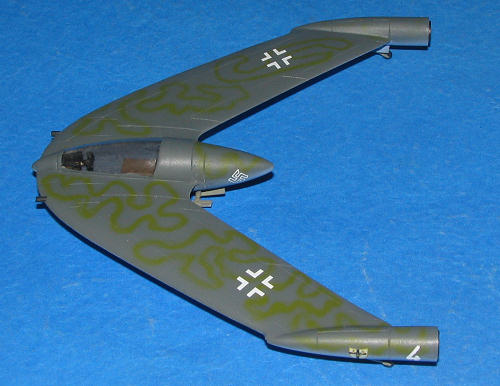 aining
group and gingerly headed for home. He had great difficulty flying the plane
with an engine out as the yaw was so bad that he could not hold it on course
when power was applied. His 'cure' was to climb in a spiral when applying power
and then correct the course when he went into glide mode. This was extremely
tiring and by the time the base was in sight, he was drenched in sweat.
aining
group and gingerly headed for home. He had great difficulty flying the plane
with an engine out as the yaw was so bad that he could not hold it on course
when power was applied. His 'cure' was to climb in a spiral when applying power
and then correct the course when he went into glide mode. This was extremely
tiring and by the time the base was in sight, he was drenched in sweat.
Landing these planes was not easy due to the skids. Next version will HAVE to have wheels with brakes. Fortunately, there was a drag spike incorporated so that once the plane hit, this would dig into the ground to help slow the plane, otherwise it would slide forever on the snow! There were also straw embankments around the perimeter in case they were needed. Dieter had used them once and lost teeth because of it. This time, despite the bad engine, the landing was near flawless and he skidded to a stop well before the embankments. His crew chief came out to the plane in the lifting dolly with a sour look on his face. He was not looking forward to replacing the damaged engine, especially when the hangar never seemed warm enough.
Dieter commiserated with the crew chief, but deep down inside, he was happy that not only had he gotten a kill, but thanks to the damage and long repair time, he'd be able to sleep in tomorrow!
| THE KIT |
Molded
by Anigrand Craftworks in Hong Kong, it has all of the attributes of kits from
that maker. Engraved panel lines, a single vacuformed canopy and generally well
detailed parts. It also has a few molding glitches that the builder will have to
deal with like some small air pockets, attachment holes that will need
additional drilling out, a few broken pins and some seams from mold slip (on the
wingtip pods)
that will need to be sanded down and/or filled. I also found some resin build-up
in the back of the wing pod skid wells which will be best taken care of with a
motor tool. While this may sound like a lot of additional work, it is pretty
much 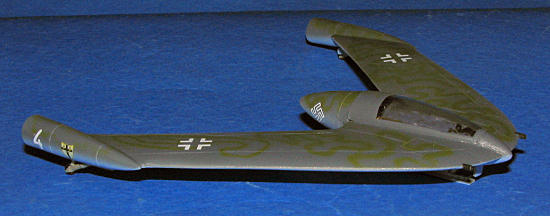 part and parcel of what one normally has to go through with resin kits. Anigrand moldings are by far better than the majority of kits I've seen over the
years.
part and parcel of what one normally has to go through with resin kits. Anigrand moldings are by far better than the majority of kits I've seen over the
years.
The aircraft basically lands and takes off on skids. The skid wells in the fuselage and wing pods are provided along with the skids, retraction struts and doors. The doors are a bit on the thick side so you may want to sand the ones for the tip pods down a bit. The main one is just fine as it is. This kit includes a pilot figure lying prone with his hands on the control wheel. It means that if you do not include the figure, you'll have a rather large empty cockpit. The figure is well molded and appears to be wearing late war garb. He also could be a figure from an old Airfix or Matchbox kit for all I know!
Instructions are very well done with step by step building guides and photos of the actual kit for each step. Definitely helps a great deal to be sure that all the bits are where they should be. Included are painting information and markings for both a Luftwaffe and Soviet Air Force aircraft. The decals are nicely printed and if like the last kit, they are very thin, on a single carrier and will need to be cut out. You get extra swastikas and small red stars to place on the tail boom. Of course, since this plane never got beyond the concept stage, you can paint and mark it any way that you wish.
| CONSTRUCTION |
Step one was to prep the parts. With short run resin
kits, the quality of the casting will often be different from one to another.
This is caused not by the mold itself, but as often as not to luck and how
quickly the parts are cast. Now I know zilch about the process at Anigrand, but
I can tell you that their kits are not always uniform from one to another. This
particular one came out a bit lower on the scale than most. By this I mean that
the tip pods both had some rath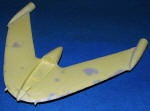 er big mold slip and the wing itself was pocked
with little dimples. These dimples are like hail damage on a car, though they
are caused by small air pockets that form in between the inside of the mold and
the resin as it cures. These are not a problem to fix as one simply does a
couple coats of filler to take care of it, but it does add several days to the
project. Fortunately, this will all be covered with primer as there is no huge
expanse of unpainted metal on my Luft '46 kits!
er big mold slip and the wing itself was pocked
with little dimples. These dimples are like hail damage on a car, though they
are caused by small air pockets that form in between the inside of the mold and
the resin as it cures. These are not a problem to fix as one simply does a
couple coats of filler to take care of it, but it does add several days to the
project. Fortunately, this will all be covered with primer as there is no huge
expanse of unpainted metal on my Luft '46 kits!
After sanding things down, I applied a couple of coats of Mr. Surfacer 500 and some standard filler for the big parts. Then the holes in the wingtip pods were drilled out (most were somewhat filled with resin) and the mating surfaces on the wing were cleaned up. The tabs on the wing tips are helpful, though both my tips had one missing/broken. The engine pods were then glued in place and the instrument panel was also attached. There was a considerable gap 'tween the tips and pods that needed more filler. Once the gaps were done, I sprayed the entire kit with Alclad II primer. This was then sanded down with 600 grit paper to get rid of the roughness that is standard with the Alclad primer. The interior was painted and the control wheel installed. Frankly, I doubt if a person laying on his stomach would be using a wheel to control flight! More than likely a short control stick. I did not use the pilot that was included, though it would have covered a plethora of ills in regards to a rather barren cockpit!
My next step was to trim the canopy. This, for me, is
not an easy task. I generally get it darn close and then do something stupid and
over-trim (one of the reasons why I always ask companies to include TWO vac
canopies). Well, I did so on this one as well, but was able to cover it up
somewhat when it was cemented in place. For this I use white glue to get it
pretty well where I want it and do some minor 'reinforcing' in some spots with
super glue. This type of canopy is relatively easy to do, though once it is cut
out, it is difficult to keep it from splaying out at the base. As a suggestion,
when using these simple canopies, make the lower sections extra long and design
them to fit INSIDE the cockpit walls. May mean making the cockpit opening a bit
wider than norm however, it
 makes
attachment super easy and also prevents the problem with splaying.
makes
attachment super easy and also prevents the problem with splaying.
Anyhow, once that was installed I glued on the gear doors. These are, of course, grossly over-thick for the scale, but I use what is provided when doing supplied review kits. You may want to replace them with pieces of plastic card or sheet brass for a more scale size.
| COLORS & MARKINGS |
Luft '46 means just about anything goes in terms of colors and so it was with this one. I painted it RLM 88 blue on the underside (which looks suspiciously like Azure Blue) and RLM 75 on the upper surfaces. Then, I used RLM 91 (which looks a lot like US Interior Green) in a wave pattern on the top using my excellent Skybow 100 fine painting airbrush. This airbrush allowed me to go over each squiggly line a couple of time to increase the color saturation without getting it too wide.
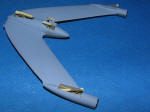 Returning to the work bench, the gear wells and landing
gear struts were painted RLM 02 and left to dry. I also painted the exhaust
sections with Model Master Burnt Iron. I then glued in the various landing gear
bits. Now this is where the fun comes in. For the nose gear/skid, I had to trim
off a section to get it to lie somewhat flush with the ground. The main gear
struts were both angled off
Returning to the work bench, the gear wells and landing
gear struts were painted RLM 02 and left to dry. I also painted the exhaust
sections with Model Master Burnt Iron. I then glued in the various landing gear
bits. Now this is where the fun comes in. For the nose gear/skid, I had to trim
off a section to get it to lie somewhat flush with the ground. The main gear
struts were both angled off  in
the same direction. Meant one fit great and the other didn't. I used the how
water technique to remold the other strut, but ended up breaking it off.
Superglue fixed that and it was glued in place. The outrigger struts need to
have the shorter strut well out of the well to get them to touch the ground.
These could be attached to the door if one wished as they look as if they were
designed to do so. It is difficult to tell from the instructions as the photo
there was not very helpful in attaching these or the rear gear legs. It was just
not that clear an image to be of use. This is a case where drawings might not be
a better idea.
in
the same direction. Meant one fit great and the other didn't. I used the how
water technique to remold the other strut, but ended up breaking it off.
Superglue fixed that and it was glued in place. The outrigger struts need to
have the shorter strut well out of the well to get them to touch the ground.
These could be attached to the door if one wished as they look as if they were
designed to do so. It is difficult to tell from the instructions as the photo
there was not very helpful in attaching these or the rear gear legs. It was just
not that clear an image to be of use. This is a case where drawings might not be
a better idea.
With those on and painted (I painted the underside of the main skid my RLM 88 and the rear skids with aluminum), it was time for a clear coat and then decals. I didn't use the kit decals but some basic insignia from a couple of sets of Siga decals that I had. These worked perfectly. I robbed a unit marking from a Hasegawa Bf-109G kit sheet and the aircraft numbers from a Mikro Yak-1 sheet. Thought that putting them out on the pods was a neat idea.
| FINAL CONSTRUCTION |
Actually, there wasn't any actual construction. I just did a bit of touch up painting, drilled out the gun barrels and painted them black. Then a clear matte coat, removal of the canopy masking that that was it.
| CONCLUSIONS |
I've now another great Luft '46 model to add to my ever growing collection. I love stuff like this for two reasons. One is that most of them are pretty basic kits without a lot of fiddly stuff. Another is that I can paint them anyway I want and so far, I've no two painted alike. Makes for a great collection and I think you'll find this one is something a bit special. A great kit for a first resin kit, and one I'm sure you'll like as much as I.
September 2006
#1432 in a series.
Copyright ModelingMadness.com. All rights reserved. No reproduction in part or in whole without express permission from the editor.
My thanks to
Fantastic Plastic for providing the review kit. You can get yours direct at
the link.
If you would like your product reviewed fairly and fairly quickly, please
contact
the editor or see other details in the
Note to
Contributors.